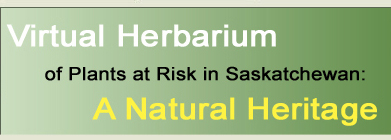
|

|

|

|

|

|

|
|
|
|
|
|
| Oxytropis campestris var. dispar (A. Nels.) Barneby | Species Image Gallery (opens in a new window) |
||||||||||||||||||||||||||||||||||||||
| TAXONOMY | |||||||||||||||||||||||||||||||||||||||
| Family: | Fabaceae | ||||||||||||||||||||||||||||||||||||||
| Genus: | Oxytropis | ||||||||||||||||||||||||||||||||||||||
| Species Synonyms: | Oxytropis dispar (A. Nels.) K. Schum Oxytropis monticola ssp. dispar (A. Nels.) Elisens & Packer |
||||||||||||||||||||||||||||||||||||||
| Common Names: | field locoweed northern yellow locoweed |
||||||||||||||||||||||||||||||||||||||
| DISTRIBUTION | |||||||||||||||||||||||||||||||||||||||
| Canada: | western Mackenzie District – Alberta – Manitoba | ||||||||||||||||||||||||||||||||||||||
| Saskatchewan: | eastern Saskatchewan; Sylvania – Indian Head | ||||||||||||||||||||||||||||||||||||||
| Ecoregion: | Aspen Parkland, Boreal Transition | ||||||||||||||||||||||||||||||||||||||
| HABITAT | |||||||||||||||||||||||||||||||||||||||
| Saskatchewan: | sandy grasslands and open woods | ||||||||||||||||||||||||||||||||||||||
| RARITY STATUS | |||||||||||||||||||||||||||||||||||||||
| Provincial
Status According to Harms (2003): |
Endangered |
||||||||||||||||||||||||||||||||||||||
| Nature Conservancy Status: | G5 N1T3 S1 |
||||||||||||||||||||||||||||||||||||||
| Saskatchewan
Species at Risk Status: |
None |
||||||||||||||||||||||||||||||||||||||
| COSEWIC Status: | None |
||||||||||||||||||||||||||||||||||||||
| Field locoweed is endangered in Saskatchewan because is extremely rare and only two locations are known for this species. Both populations are locally sparse and possible threats have been identified. | |||||||||||||||||||||||||||||||||||||||
| SPECIES DESCRIPTION | |||||||||||||||||||||||||||||||||||||||
| Roots: | taproots stout | ||||||||||||||||||||||||||||||||||||||
| Stems: | caudex multiple underground; stem absent | ||||||||||||||||||||||||||||||||||||||
| Stipules: | 4 – 16 m long, nearly hairless or long hairy | ||||||||||||||||||||||||||||||||||||||
| Leaves: | odd-pinnate, weakly to strongly different, may be two kinds of leaves, to 3 cm long, linear to egg-shaped, long hairy | ||||||||||||||||||||||||||||||||||||||
| Leaflets: | 9 – 19, 4 – 20 mm long, 1 – 4 mm wide, scattered, elliptic to lance-shaped, hairy on both sides | ||||||||||||||||||||||||||||||||||||||
| Inflorescence: | unbranched, 8 – 20-flowered; bracts hairy; inflorescence stalk erect, 10 – 40 cm long | ||||||||||||||||||||||||||||||||||||||
| Flowers: | sepals tube 6 – 7 mm long, white-hairy, with short, appressed, brown or black hairs; petals pink, blue or purple; banner 12 – 19 mm long; wings 10 – 16 mm long; keel 10 – 14 mm long | ||||||||||||||||||||||||||||||||||||||
| Fruits: | pod nearly stalkless, 8 – 16 mm long, beak to 5 mm long, oblong to ellipsoid, short hairy with black and white hairs; seeds dark brown, smooth | ||||||||||||||||||||||||||||||||||||||
| |||||||||||||||||||||||||||||||||||||||